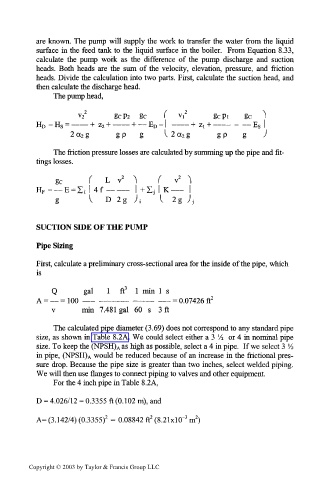Page 481 - Chemical process engineering design and economics
P. 481
458 Chapter 8
are known. The pump will supply the work to transfer the water from the liquid
surface in the feed tank to the liquid surface in the boiler. From Equation 8.33,
calculate the pump work as the difference of the pump discharge and suction
heads. Both heads are the sum of the velocity, elevation, pressure, and friction
heads. Divide the calculation into two parts. First, calculate the suction head, and
then calculate the discharge head.
The pump head,
2 2
v 2 gcP2 gc ( v, gcpi g c "\
H D -H S = ——— + z 2 + ——— + — E D- ——— + zi + ——— - — E s I
2 cc 2 g gp g I 2 a 2 g gp g )
The friction pressure losses are calculated by summing up the pipe and fit-
tings losses.
gc ( L v 2 ^ ( v 2 ^
H F =_E = I; | 4f — —— I Zj | K —— |
+
g I D 2g )i I 2g Jj
SUCTION SIDE OF THE PUMP
Pipe Sizing
First, calculate a preliminary cross-sectional area for the inside of the pipe, which
is
Q gal 1 ft 3 1 min 1 s
A = — =100 —— ————— ——— —— = 0.07426 ft 2
v min 7.481 gal 60 s 3 ft
The calculated pipe diameter (3.69) does not correspond to any standard pipe
size, as shown in Table 8.2A. We could select either a 3 Vi or 4 in nominal pipe
size. To keep the (NPSH) Aas high as possible, select a 4 in pipe. If we select 3 '/•>
in pipe, (NPSH) A would be reduced because of an increase in the frictional pres-
sure drop. Because the pipe size is greater than two inches, select welded piping.
We will then use flanges to connect piping to valves and other equipment.
For the 4 inch pipe in Table 8.2A,
D = 4.026/12 = 0.3355 ft (0.102 m), and
2
3
2
2
A= (3.142/4) (0.3355) = 0.08842 ft (8.21xlO~ m )
Copyright © 2003 by Taylor & Francis Group LLC

